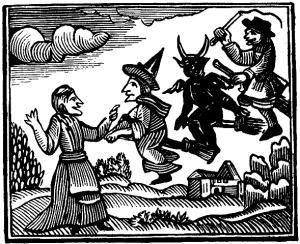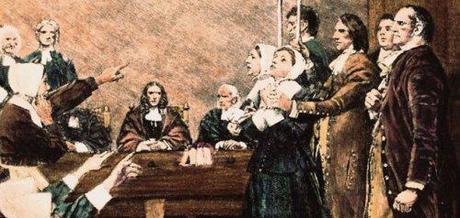Even when we understand that memories can be altered, or even fabricated…the truth is difficult to accept; after all, our memories certainly seem permanent, and we might like to believe that things we have forgotten have merely been mislaid, like old VHS tapes consigned to a box at the back of a closet and covered with old clothes. – “Mind-witness Testimony”
If you haven’t yet read my research paper, “Mind-witness Testimony”, you really ought to; it expands at much greater length and in much greater detail on the themes I discussed in “Imagination Pinned Down” and “I Disbelieve It!”, mocked in “Mulberry Street” and mentioned in passing in “Traffic Jam”, “The Swedish Cult”, “That Old Black Magic”, “Mumbo Jumbo” and many other places. The Reader’s Digest version is:
…The human mind doesn’t passively record events as a camera does; memory is an active and dynamic process which retains information by fitting it into schemata, mental frameworks which shape our thinking and give meaning to perceptions…The same psychological mechanism which causes us to find pictures in Rorschach’s inkblots also causes us to fit memories into the complex web of schemata by which we interpret the world. And just as we ignore those topological elements of a cloud or inkblot which do not fit the meaning our minds have imposed upon it, so do we forget or distort elements of a memory which fail to conform to the schema in which we have embedded it, or even invent elements which were not in reality present, but which the schema predicts should be…The human mind often completely fabricates memories in order to impose conformity with one’s weltanschauung. One simple example involves police lineups: people will often identify the man whom police imply (subtly or overtly) is their preferred suspect because they believe police to be expert assessors of guilt who would never implicate someone falsely, and this schema of police authority and infallibility actually shapes their memories, sometimes to the point of identifying a person who is later proven to look absolutely nothing like the actual criminal…
 In witch hunts of both the classic and modern varieties, hypersuggestible people such as children, the mentally ill, the emotionally needy or the severely traumatized can be induced to “remember” all sorts of fantastic things which are not even physically possible, much less grounded in actual events; when they repeat these “memories” in court (or in front of audiences hungry for “sex trafficking” narratives) they are not lying in the strict sense, but merely playing back a script that was written into their memories by processes such as suggestion, group polarization, stereotypic conformation, guided imagination, abusive interrogation tactics and others discussed in my paper. Though the concept of “recovered memory” has been discredited and most reasonably-well-informed people understand its role in driving the Satanic panic, few have yet connected the dots to recognize “sex trafficking” narratives as produced by the same processes. However, as the public begins to recognize driving the Satanic panic, few have yet connected the dots to recognize “sex trafficking” narratives as produced by the same processes. However, as the public begins to recognize the fallibility of human memory, it’s inevitable that outlandish, evidence-free stories such as those told by Somaly Mam, Chong Kim and Theresa Flores will be treated with greater skepticism. And though it’s a slow process, that knowledge is indeed growing; witness, for example, this treatment of a new resurgence of the “Satanic cult abuse” myth:
In witch hunts of both the classic and modern varieties, hypersuggestible people such as children, the mentally ill, the emotionally needy or the severely traumatized can be induced to “remember” all sorts of fantastic things which are not even physically possible, much less grounded in actual events; when they repeat these “memories” in court (or in front of audiences hungry for “sex trafficking” narratives) they are not lying in the strict sense, but merely playing back a script that was written into their memories by processes such as suggestion, group polarization, stereotypic conformation, guided imagination, abusive interrogation tactics and others discussed in my paper. Though the concept of “recovered memory” has been discredited and most reasonably-well-informed people understand its role in driving the Satanic panic, few have yet connected the dots to recognize “sex trafficking” narratives as produced by the same processes. However, as the public begins to recognize driving the Satanic panic, few have yet connected the dots to recognize “sex trafficking” narratives as produced by the same processes. However, as the public begins to recognize the fallibility of human memory, it’s inevitable that outlandish, evidence-free stories such as those told by Somaly Mam, Chong Kim and Theresa Flores will be treated with greater skepticism. And though it’s a slow process, that knowledge is indeed growing; witness, for example, this treatment of a new resurgence of the “Satanic cult abuse” myth:
…two [Scottish] charities…Break the Silence and…Izzy’s Promise, believe satanic [sic] abuse to be rife in Scotland and that it has been for decades. They say children are forced to take part in satanic [sic] rituals involving the sacrifice of babies and the making of snuff movies….it appears highly likely that…these claims are based upon “recovered memories”. As I have written in the past in these pages, the use of various dubious techniques…aimed at recovering allegedly repressed memories of childhood sexual abuse can often produce detailed and horrific false memories. In fact, there is a consensus among scientists studying memory that traumatic events are more likely to be remembered than forgotten, often leading to posttraumatic stress disorder…The sad truth is that we have been here before. [Satanic fantasies of the early ’90s]…were remarkably similar to those now…
Memory, as experts have been trying to teach judges and jurors, does not function like an iPhone camera recording. Memories can not only be deleted; they can be altered or invented without you even realizing it, as shown in a study published last year in the International Journal of Law and Psychiatry, which involved 861 U.S. soldiers enrolled in a survival school. As part of training, they endured abusive interrogations. Afterward, many were shown a photo of someone who looked nothing like their interrogator, and interviewers insinuated that the person depicted was the culprit. Eighty-four percent of the soldiers misidentified their interrogators after being misled, and some also remembered weapons or telephones that never existed. An extensive body of research with similar findings has become increasingly perplexing for the nation’s judicial systems, leading the National Academy of Sciences (NAS) to release a sweeping report last month calling for an overhaul of how the courts and law enforcement deal with one of the most powerfully persuasive pieces of evidence that can sway a jury: eyewitness identification. Research has shown that leading questioning or suggestive behavior by psychiatrists, police or acquaintances, as well as accounts in the media, can result in “planting” false memories in the mind of a witness. In some cases, this can lead witnesses to believe they saw incidents that never occurred…Unsettling as it might be to admit it, the mind is really a muddle of distorted memory associations, further complicated by the distracting details of the moment. For most of our country’s judicial history, this understanding has been largely absent from courtrooms, but a string of shocking cases across the world over the past three decades has ushered in debate, discussion and, finally, the revamping of…laws on the issue…
Belief in the infallibility of memories, especially traumatic memories, is deeply ingrained, and prosecutors will not be happy about the replacement of easily-manipulated crime victim testimony with more indelible and objective forms of evidence. But sooner or later, the facts must win and eyewitness testimony uncorroborated by physical evidence will be tossed into the rubbish-bin of history along with trial by ordeal and, one would hope, confessions obtained by torture. Moral panics will periodically bedevil humanity for at least another several thousand years, but perhaps our children’s children will no longer have to endure trials and laws based on nothing but the incredible and unsubstantiated narratives of self-professed victims. 
